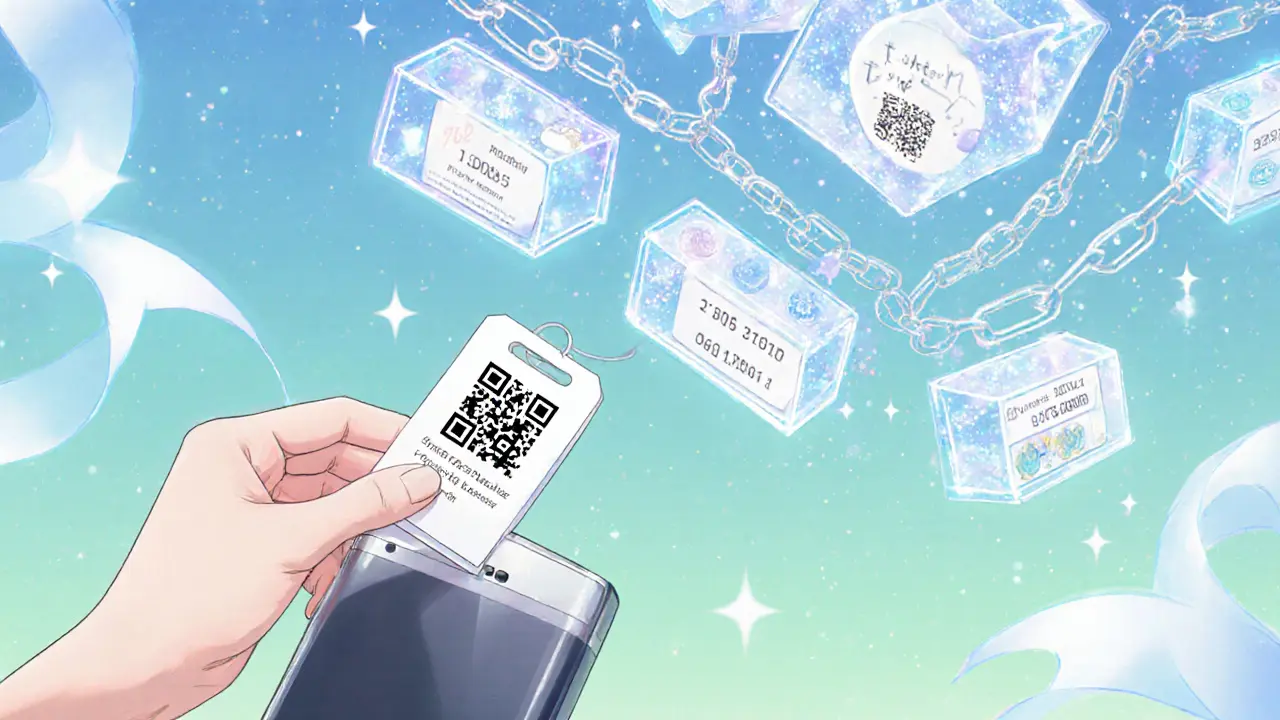Blockchain Anti-Counterfeiting Verification Simulator
When a luxury watch or a life‑saving medicine turns out to be fake, the damage is immediate-lost revenue, brand damage, and sometimes health risks. Blockchain anti-counterfeiting solution is a digital system that uses blockchain technology to verify product authenticity and prevent counterfeiting. By storing a tamper‑proof record of every product’s journey, these systems give manufacturers, retailers, and shoppers a single source of truth they can trust.
Quick takeaways
- Each genuine item gets a unique digital token recorded on an immutable ledger.
- Physical tags (QR codes, RFID, smart labels) link the product to its blockchain record.
- Smart contracts automate alerts whenever counterfeit activity is detected.
- High‑value sectors-luxury goods, pharma, electronics-see the biggest ROI.
- Implementation costs are higher than traditional holograms, but the security payoff is exponential.
How blockchain creates a reliable authentication layer
At its core, blockchain is a distributed database where every transaction is cryptographically sealed and linked to the previous one. When a product is born, the manufacturer creates a digital token that contains:
- A serial number or unique identifier (often printed as a QR code or embedded in an RFID chip).
- Key product attributes: model, batch, production date, and certification details.
- Provenance data: where the raw materials came from and which factory assembled the item.
That token is then broadcast to the blockchain network. From that moment on, every hand‑off-warehouse, distributor, retailer-adds a new immutable entry. The result is an end‑to‑end audit trail that anyone with a smartphone can view by scanning the physical tag.
Technical architecture: layers that work together
Most implementations follow a three‑layer model:
- Physical layer: QR codes, NFC stickers, RFID tags, or even covert inks that are hard to replicate.
- Digital layer: The blockchain ledger (public or permissioned) that stores the token and all subsequent events.
- Application layer: Mobile apps or web portals that let users read the tag, query the ledger, and receive a verification status.
Smart contracts sit in the digital layer and automatically trigger actions-such as sending an alert to the brand’s security team-if a token is flagged as duplicated or if a transaction occurs out of the expected supply‑chain path.
Why blockchain beats traditional anti‑counterfeiting methods
| Feature | Traditional methods (holograms, simple QR codes) | Blockchain solutions |
|---|---|---|
| Data integrity | Can be altered or copied; relies on centralized databases. | Immutable ledger; any tampering is instantly visible. |
| Verification process | Often requires brand‑specific apps or manual inspection. | Open, decentralized verification via any standard smartphone. |
| Scalability across supply chain | Limited to point‑of‑sale checks. | Tracks every transaction from raw material to end consumer. |
| Cost per unit | Low (printing hologram). | Higher upfront (digital token creation, smart tag). |
| Resistance to sophisticated replication | Vulnerable to high‑resolution printing. | Combines cryptographic proof with physical security, making duplication extremely difficult. |
In short, the blockchain approach adds a dynamic, data‑driven layer that physical features alone can’t provide.

Real‑world use cases that illustrate the value
Luxury fashion houses have begun embedding QR‑enabled smart labels on handbags. A shopper scans the label, sees the full production timeline, and gets a genuine badge-counterfeit replicas instantly fail the check.
In the pharmaceutical industry, a major vaccine manufacturer links each vial to a blockchain token. Hospitals can verify authenticity at the point of administration, cutting down on fake vaccines that have caused outbreaks in the past.
Electronics makers protect high‑value components such as micro‑chips by placing RFID tags that write to a permissioned blockchain. If a counterfeit component tries to enter the assembly line, the system flags it before the device is shipped.
Implementation challenges and how to overcome them
While the benefits are clear, rolling out a blockchain anti‑counterfeiting system isn’t as simple as printing a new sticker. Below are the most common hurdles and practical tips:
- Scalability: Public blockchains can slow down with millions of transactions. Opt for a permissioned ledger (e.g., Hyperledger Fabric) that offers higher throughput for supply‑chain use cases.
- Integration with legacy ERP systems: Use middleware that translates existing purchase‑order data into blockchain‑compatible events. APIs that follow the ISO 20022 standard can streamline this step.
- User adoption: Consumers must find the verification step easy. Provide a simple QR‑scan app that returns a clear Authentic or Fake badge in seconds.
- Physical tag security: Tags themselves can be copied. Combine overt tags (QR) with covert features like invisible inks or micro‑printing that only specialized equipment can read.
- Cost justification: Conduct a ROI analysis that factors in reduced counterfeiting losses, brand‑value protection, and potential insurance premium reductions.
Best‑practice checklist for a successful rollout
- Define the product scope: start with high‑margin items where counterfeit loss exceeds implementation cost.
- Select a blockchain platform that matches your transaction volume and privacy needs.
- Design a hybrid tag strategy: visible QR code + covert security feature.
- Develop smart contracts that log every hand‑off and trigger alerts for anomalies.
- Integrate the blockchain API with your existing supply‑chain management software.
- Run a pilot with a single product line, collect user feedback, and refine the verification UI.
- Scale gradually, adding more SKUs and partners while monitoring latency and cost per transaction.
Future trends: where the technology is heading
Analysts predict three key developments in the next five years:
- IoT‑enabled tokens: Sensors embedded in packaging will feed real‑time temperature, humidity, and location data directly to the blockchain, enhancing transparency for perishable goods.
- AI‑driven anomaly detection: Machine‑learning models will scan transaction patterns and flag suspicious activity before a counterfeit item reaches the market.
- Cost‑effective public‑chain solutions: Layer‑2 scaling solutions (e.g., Polygon, Optimism) will lower transaction fees, making blockchain viable for mid‑range products.
When these trends converge, even everyday consumer goods could carry a blockchain‑backed authenticity badge.
Frequently Asked Questions
What exactly is a blockchain anti‑counterfeiting solution?
It is a system that couples a physical identifier (like a QR code or RFID tag) with a digital token recorded on a blockchain. The token stores immutable data about the product’s origin, history, and ownership, allowing anyone to verify authenticity in real time.
Can small businesses afford this technology?
While early adopters focused on high‑value items, emerging Layer‑2 solutions and shared‑infrastructure services are reducing costs. A small business can start with a pilot on a permissioned blockchain and expand as ROI becomes evident.
How does a consumer verify a product?
The consumer scans the QR or NFC tag with a mobile app. The app reads the token ID, queries the blockchain, and displays a clear status-genuine or counterfeit-along with provenance details.
What happens if a token is duplicated?
Because the blockchain records each token only once, any attempt to register a duplicate will be rejected by the network’s consensus rules. Smart contracts can also send immediate alerts to the brand’s security team.
Is blockchain privacy a concern?
Permissioned blockchains keep data visible only to authorized participants, protecting commercial secrets while still offering transparency for verification.


Shamalama Dee
June 1, 2025 AT 01:14Blockchain anti‑counterfeiting blends a physical tag with a digital token, giving shoppers a quick way to verify authenticity. By scanning a QR code or tapping an NFC sticker, the app queries an immutable ledger and flashes a genuine or fake badge. This creates a single source of truth that manufacturers, retailers, and consumers can all trust. The system also logs every hand‑off, from factory to storefront, so any deviation shows up instantly. Because the data can’t be altered retroactively, counterfeiters lose the ability to replay or forge records.
scott bell
June 2, 2025 AT 05:01Scanning feels like unlocking a secret vault hidden in plain sight
vincent gaytano
June 3, 2025 AT 08:47The promise of blockchain as a silver bullet against fakes sounds almost utopian.
Yet every new technology brings its own attack surface, and crypto‑ledgers are no exception.
Centralized databases can be hacked, but distributed ledgers rely on consensus mechanisms that can be gamed.
Powerful actors could collude to whitelist counterfeit tokens, rendering the system moot.
Moreover, the sheer volume of transactions required for global supply chains could choke public networks, forcing a switch to obscure permissioned chains.
Those private chains often hide their own opacity behind proprietary APIs.
If the data feed that populates the token is compromised, the blockchain merely records falsehoods.
Imagine a scenario where a manufacturer outsources tag printing to a third party that inserts duplicate IDs.
The ledger will happily accept each entry as genuine because it cannot tell the difference between a real and a forged identifier.
In addition, the cost of generating and maintaining smart contracts can eat into profit margins, especially for small businesses.
Many brands roll out flashy QR stickers while neglecting the underlying logistics that made the product authentic in the first place.
The end consumer, armed with a smartphone, may feel empowered, yet they remain vulnerable to social engineering.
A counterfeitist could simply direct users to a phishing site that mimics the verification app.
Ultimately, the technology is only as trustworthy as the people and processes that feed it.
So while blockchain adds a layer of cryptographic proof, it does not eliminate the human factor that counterfeiters exploit.
Dyeshanae Navarro
June 4, 2025 AT 12:34The point is that no system is foolproof we still need good oversight
Matt Potter
June 5, 2025 AT 16:21Absolutely! Embracing blockchain now puts brands ahead of the curve and sends a clear message to counterfeiters-stop trying, we’re watching every move. The transparency it offers can turn supply‑chain chaos into a competitive advantage, and the ROI shows up fast when fraud drops.
Marli Ramos
June 6, 2025 AT 20:07idk lol u r right 😂
Christina Lombardi-Somaschini
June 7, 2025 AT 23:54Indeed, the strategic deployment of immutable ledgers not only deters illicit replication but also cultivates consumer confidence; the measurable decline in counterfeit incidents substantiates the investment, thereby justifying the initial expenditure.
katie sears
June 9, 2025 AT 03:41When evaluating blockchain solutions, it’s vital to align the technology stack with existing ERP workflows. Integrating middleware that translates purchase‑order data into blockchain events minimizes disruption and preserves data integrity. Additionally, opting for a permissioned ledger can balance privacy concerns with the need for transparency across trusted partners.
Gaurav Joshi
June 10, 2025 AT 07:27That’s spot on we need to keep things simple yet secure
Kathryn Moore
June 11, 2025 AT 11:14Blockchain records are immutable which means once data is written it cannot be altered without network consensus
Christine Wray
June 12, 2025 AT 15:01While immutability is a strength, it also raises questions about error correction; if a wrong entry slips in, fixing it requires a new transaction rather than an edit, which can clutter the ledger over time.
roshan nair
June 13, 2025 AT 18:47Great point! The ledger’s “once‑and‑for‑all” nature is like a tattoo on data-awesome for authenticity but a bit brutal when you need a quick fix. In practice, we often spawn a corrective smart‑contract that appends a “reversal” note, so the original mistake stays visible but is effectively nullified. This approach keeps the chain honest while giving us a safety net, albeit a somewhat flashy one.
Jay K
June 14, 2025 AT 22:34Consequently, adopting a layered correction mechanism preserves the audit trail’s integrity and satisfies regulatory requirements, ensuring that both provenance and accountability remain uncompromised.